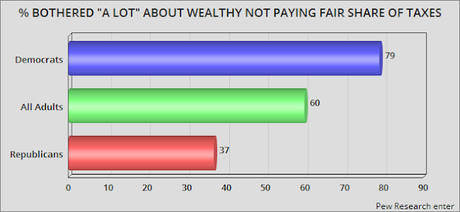
The chart above reflects results of a recent Pew Research Center survey -- done between March 20th and 25th of a national sample of 1,503 adults, with a 3 point margin of error.
The Republicans thought they would win voters over with their tax cuts. They didn't. The public quickly realized that most of those cuts went to the very rich (and corporations, which also benefitted the rich). And they didn't like it.
The public thinks the rich don't pay their fair share of income taxes. And as the chart above shows, about 60% of that public says that bothers them "a lot". Another 20% says it bothers them "some". Only a tiny 19% says it doesn't bother them much or at all.
This is very likely to be an issue in the next election -- especially with millions getting less or nothing in refunds this year.
Democrats have already started to campaign on more taxes for the rich. Elizabeth Warren, Alexandria Ocasio-Cortez, and others are coming up with plans to tax the rich more.
Here is an interesting concept for taxing the super wealthy from Josh Bivins at the Economic Policy Institute:
Excessive wealth and power commanded by a small group of multi-millionaires and billionaires—the richest one-tenth of 1 percent—poses an existential threat to America’s economic vitality, democracy, and civil society. It’s well-known by now that the richest 1 percent of American households have essentially doubled the share of national income they claim since the late 1970s. Less well-known is that inequality has even risen within the top 1 percent, with the top 10 percent of that overall group—or the top 0.1 percent—accounting for half of all income within the top 1 percent. The political clout of this top 0.1 percent is likely even more outsized then their share of overall income. This group’s incomes overwhelmingly stem from owning financial assets, not working in labor markets. This means that they benefit from the preferential tax treatment given to income from wealth relative to income from work. The Trump tax cut at the end of 2017 was tailor-made for the top 0.1 percent, as its largest cuts accrue to business owners, both corporate and non-corporate. Countering the power wielded by the top 0.1 percent will require ambitious policy changes across a range of issues. Steeply progressive taxes have recently been proposed by a number of policymakers and economists as key ingredients in the overall policy portfolio meant to restrain the power of the super-rich. One idea that has not yet gotten the attention it deserves in this discussion is a surtax on the incomes of the top 0.1 percent. A surtax has a number of advantages as a tool for checking the power of the rich. First, it’s laser-targeted on their incomes, phasing in only at the threshold of the top 0.1 percent. Second, it does not provide preferential treatment for wealth-based incomes relative to work-based incomes—it applies to every dollar of any kind over the income threshold. Third, this neutrality across types of incomes means that in the long run it would be hard to avoid or evade. Proposal: A 10 percent surtax on the top 0.1 percent We propose a 10 percent surtax on all income over the top 0.1 percent threshold. For simplicity, the income threshold should be defined by a taxpayer’s adjusted gross income (AGI). The threshold for the tax should be determined by the IRS to have only the top 0.1 percent affected in the first year, then it should be indexed by overall inflation. In the last year of IRS dataavailable (2016), this top 0.1 percent threshold was $2.3 million. The surtax would apply to all income above AGI, including dividends and realized capital gains. How much revenue might a 10 percent surtax on the top 0.1 percent raise? Our preliminary estimate is that such a surtax would raise roughly $75 billion in its first year of implementation and roughly $800 billion in its first decade. The methodology for this estimate is fairly straightforward. First, we estimate how much total AGI is recorded by the top 0.1 percent. In 2019, we estimate that as roughly $1.17 trillion. Second, we estimate how much of the income of the top 0.1 percent of households would be exempt from the surtax by falling under the threshold, which is simply the number of tax filers in the top 0.1 percent multiplied by the tax’s threshold. With roughly 150,000 filers in the top 0.1 percent estimated for 2019, this implies that about $450 billion exempt from the tax, making the overall base roughly $720 billion. Third, we multiply this base by 10 percent to get $72 billion raised in its first year. In later years, we let the number of tax filers and their AGI rise at rates that have characterized the past ten years and making similar calculations for each of those years. Over the next decade this implies revenue of roughly $800 billion. $75 billion is a lot of money, even in the context of the federal budget. $75 billion is, for example, the cost of providing universal high-quality pre-kindergarten for all 3 and 4 year olds in the United States, plus providing substantial aid for paying for high-quality childcare for all 0-2 year olds. This sort of ambitious investment in America’s children would provide huge benefits to American society and economic efficiency, and is just one example of how the income currently claimed by the very rich could be put to better use.

